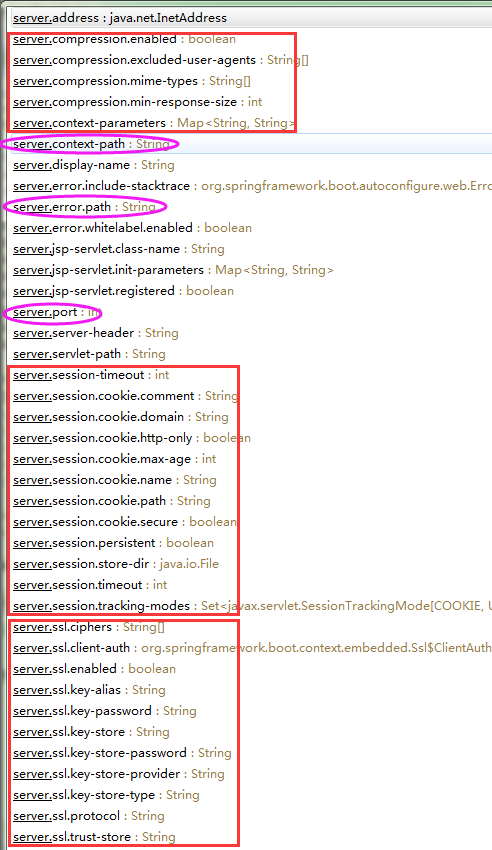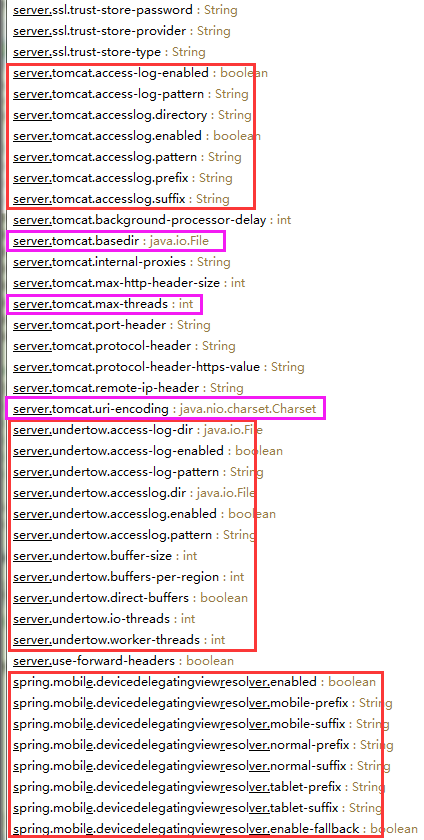Spring Boot 其默认是集成web容器的,启动方式由像普通Java程序一样,main函数入口启动。其内置Tomcat容器或Jetty容器,具体由配置来决定(默认Tomcat)。当然你也可以将项目打包成war包,放到独立的web容器中(Tomcat、weblogic等等),当然在此之前你要对程序入口做简单调整。
项目构建我们使用Maven或Gradle,这将使项目依赖、jar包管理、以及打包部署变的非常方便。
一、内嵌 Server 配置
Spring Boot将容器内置后,它通过配置文件的方式类修改相关server配置。
先看一下下面的图,为关于server的配置列项: 
其中常用的配置只有少数几个,已经用紫色标记起来。红框圈起来的部分,看名称分类就可以明白其作用。
对server的几个常用的配置做个简单说明:
[java] view plaincopyprint?
- # 项目contextPath,一般在正式发布版本中,我们不配置
- server.context-path=/myspringboot
- # 错误页,指定发生错误时,跳转的URL。请查看BasicErrorController源码便知
- server.error.path=/error
- # 服务端口
- server.port=9090
- # session最大超时时间(分钟),默认为30
- server.session-timeout=60
- # 该服务绑定IP地址,启动服务器时如本机不是该IP地址则抛出异常启动失败,只有特殊需求的情况下才配置
- # server.address=192.168.16.11
Tomcat
Tomcat为Spring Boot的默认容器,下面是几个常用配置:
[java] view plaincopyprint?
- # tomcat最大线程数,默认为200
- server.tomcat.max-threads=800
- # tomcat的URI编码
- server.tomcat.uri-encoding=UTF-8
- # 存放Tomcat的日志、Dump等文件的临时文件夹,默认为系统的tmp文件夹(如:C:\Users\Shanhy\AppData\Local\Temp)
- server.tomcat.basedir=H:/springboot-tomcat-tmp
- # 打开Tomcat的Access日志,并可以设置日志格式的方法:
- #server.tomcat.access-log-enabled=true
- #server.tomcat.access-log-pattern=
- # accesslog目录,默认在basedir/logs
- #server.tomcat.accesslog.directory=
- # 日志文件目录
- logging.path=H:/springboot-tomcat-tmp
- # 日志文件名称,默认为spring.log
- logging.file=myapp.log
Jetty
如果你要选择Jetty,也非常简单,就是把pom中的tomcat依赖排除,并加入Jetty容器的依赖,如下:
[java] view plaincopyprint?
- <dependencies>
- <dependency>
- <groupId>org.springframework.boot</groupId>
- <artifactId>spring-boot-starter-web</artifactId>
- <exclusions>
- <exclusion>
- <groupId>org.springframework.boot</groupId>
- <artifactId>spring-boot-starter-tomcat</artifactId>
- </exclusion>
- </exclusions>
- </dependency>
- <dependency>
- <groupId>org.springframework.boot</groupId>
- <artifactId>spring-boot-starter-jetty</artifactId>
- </dependency>
- <dependencies>
打包
打包方法:
CMD进入项目目录,使用 mvn clean package 命令打包,以我的项目工程为例:
[java] view plaincopyprint?
- E:\spring-boot-sample>mvn clean package
可以追加参数 -Dmaven.test.skip=true 跳过测试。
打包后的文件存放于项目下的target目录中,如:spring-boot-sample-0.0.1-SNAPSHOT.jar
如果pom配置的是war包,则为spring-boot-sample-0.0.1-SNAPSHOT.war
二、部署到JavaEE容器
- 修改启动类,继承 SpringBootServletInitializer 并重写 configure 方法
[java] view plaincopyprint?
- public class SpringBootSampleApplication extends SpringBootServletInitializer{
- private static final Logger logger = LoggerFactory.getLogger(SpringBootSampleApplication.class);
- @Override
- protected SpringApplicationBuilder configure(SpringApplicationBuilder builder) {
- return builder.sources(this.getClass());
- }
- }
- 修改pom文件中jar 为 war
[java] view plaincopyprint?
- <!-- <packaging>jar</packaging> -->
- <packaging>war</packaging>
- 修改pom,排除tomcat插件
[java] view plaincopyprint?
- <dependency>
- <groupId>org.springframework.boot</groupId>
- <artifactId>spring-boot-starter-web</artifactId>
- <exclusions>
- <exclusion>
- <groupId>org.springframework.boot</groupId>
- <artifactId>spring-boot-starter-tomcat</artifactId>
- </exclusion>
- </exclusions>
- </dependency>
- 打包部署到容器
使用命令 mvn clean package 打包后,同一般J2EE项目一样部署到web容器。
三、使用Profile区分环境
spring boot 可以在 “配置文件”、“Java代码类”、“日志配置” 中来配置profile区分不同环境执行不同的结果
1、配置文件
使用配置文件application.yml 和 application.properties 有所区别
以application.properties 为例,通过文件名来区分环境 application-{profile}.properties
application.properties
[java] view plaincopyprint?
- app.name=MyApp
- server.port=8080
- spring.profiles.active=dev
application-dev.properties
[java] view plaincopyprint?
- server.port=8081
application-stg.properties
[java] view plaincopyprint?
- server.port=8082
在启动程序的时候通过添加 –spring.profiles.active={profile} 来指定具体使用的配置
例如我们执行 java -jar demo.jar –spring.profiles.active=dev 那么上面3个文件中的内容将被如何应用?
Spring Boot 会先加载默认的配置文件,然后使用具体指定的profile中的配置去覆盖默认配置。
[java] view plaincopyprint?
- app.name 只存在于默认配置文件 application.properties 中,因为指定环境中不存在同样的配置,所以该值不会被覆盖
- server.port 默认为8080,但是我们指定了环境后,将会被覆盖。如果指定stg环境,server.port 则为 8082
- spring.profiles.active 默认指定dev环境,如果我们在运行时指定 –spring.profiles.active=stg 那么将应用stg环境,最终 server.port 的值为8082
2、Java类中@Profile注解
下面2个不同的类实现了同一个接口,@Profile注解指定了具体环境
[java] view plaincopyprint?
- // 接口定义
- public interface SendMessage {
- // 发送短信方法定义
- public void send();
- }
- // Dev 环境实现类
- @Component
- @Profile("dev")
- public class DevSendMessage implements SendMessage {
- @Override
- public void send() {
- System.out.println(">>>>>>>>Dev Send()<<<<<<<<");
- }
- }
- // Stg环境实现类
- @Component
- @Profile("stg")
- public class StgSendMessage implements SendMessage {
- @Override
- public void send() {
- System.out.println(">>>>>>>>Stg Send()<<<<<<<<");
- }
- }
- // 启动类
- @SpringBootApplication
- public class ProfiledemoApplication {
- @Value("${app.name}")
- private String name;
- @Autowired
- private SendMessage sendMessage;
- @PostConstruct
- public void init(){
- sendMessage.send();// 会根据profile指定的环境实例化对应的类
- }
- }
3、logback-spring.xml也支持有节点来支持区分
[java] view plaincopyprint?
- <?xml version="1.0" encoding="UTF-8"?>
- <configuration>
- <include resource="org/springframework/boot/logging/logback/base.xml" />
- <logger name="org.springframework.web" level="INFO"/>
- <springProfile name="default">
- <logger name="org.springboot.sample" level="TRACE" />
- </springProfile>
- <springProfile name="dev">
- <logger name="org.springboot.sample" level="DEBUG" />
- </springProfile>
- <springProfile name="staging">
- <logger name="org.springboot.sample" level="INFO" />
- </springProfile>
- </configuration>
再说一遍文件名不要用logback.xml 请使用logback-spring.xml
四、指定外部的配置文件
有些系统,关于一些数据库或其他第三方账户等信息,由于安全问题,其配置并不会提前配置在项目中暴露给开发人员。
对于这种情况,我们在运行程序的时候,可以通过参数指定一个外部配置文件。
以 demo.jar 为例,方法如下:
[java] view plaincopyprint?
- java -jar demo.jar --spring.config.location=/opt/config/application.properties
其中文件名随便定义,无固定要求。
五、创建一个Linux 应用的sh脚本
下面几个脚本仅供参考,请根据自己需要做调整
start.sh
[java] view plaincopyprint?
- #!/bin/sh
- rm -f tpid
- nohup java -jar /data/app/myapp.jar --spring.profiles.active=stg > /dev/null 2>&1 &
- echo $! > tpid
stop.sh
[java] view plaincopyprint?
- tpid=`cat tpid | awk '{print $1}'`
- tpid=`ps -aef | grep $tpid | awk '{print $2}' |grep $tpid`
- if [ ${tpid} ]; then
- kill -9 $tpid
- fi
check.sh
[java] view plaincopyprint?
- #!/bin/sh
- tpid=`cat tpid | awk '{print $1}'`
- tpid=`ps -aef | grep $tpid | awk '{print $2}' |grep $tpid`
- if [ ${tpid} ]; then
- echo App is running.
- else
- echo App is NOT running.
- fi
kill.sh
[java] view plaincopyprint?
- #!/bin/sh
- # kill -9 `ps -ef|grep 项目名称|awk '{print $2}'`
- kill -9 `ps -ef|grep demo|awk '{print $2}'`























 1105
1105

 被折叠的 条评论
为什么被折叠?
被折叠的 条评论
为什么被折叠?








